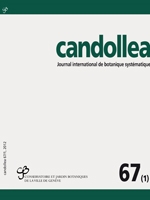Dey, S. & P. V. Prasanna (2012). Typifications of Rhynchospora hookeri Boeck., Rhynchospora longisetis R. Br. and Rhynchospora rubra (Lour.) Makino (Cyperaceae). Candollea 67: 45–50. In English, English and French abstracts.
The names of Rhynchospora hookeri Boeck. and Rhynchospora longisetis R. Br. (Cyperaceae) are lectotypified, and the name of Rhynchospora rubra (Lour.) Makino is neotypified.
Fig. 1.
Lectotypus of Rhynchospora hookeri Boeck.
[s.coll., CAL] [© Central National Herbarium, Howrah, India. Reproduced with permission]

1. Rhynchospora hookeri Boeck. in Linnaea 37: 621. 1873.
Lectotypus (designated here): INDIA: “Hook. et Thoms. Herb. Ind. Or.”, Indic. Orient., Mt. Khasia, s.d., Hooker & Thomson s.n. (CAL [0000022242]!; iso-: K [000357553]!) (Fig. 1).
Boeckeler cited “‘Hook. et Thoms. Herb. Ind. Or.', Indic. Orient, Mont. Khasia” as the type of this species. The specimen deposited in CAL, having the original label of “Hook. et Thoms.” is designated as lectotype of this species and replaces the material formerly deposited at B, which was destroyed during the Second World War (R. Vogt, pers. comm., 2005). However, Boeckeler identified the specimen as Cephalo schoenus articulatus Nees, written on the original label of the specimen at CAL which further confirms that the duplicate of the CAL specimen was studied by Boeckeler. Critical examination of the specimen reveals that it belongs to Rhynchospora hookeri Boeck. (not Cephaloschoenus articulatus Nees, presently known as Rhynchospora corymbosa (L.) Britton) and confirms C. B. Clarke's observation (Clarke, 1908).
2. Rhynchospora longisetis R. Br., Prodr.: 230. 1810.
Lectotypus (designated here): “Nova Hollandia”, s.d., Banks s.n. (BM [000901440]! (Fig. 2).
Robert Brown, while describing R. longisetis, mentioned only “Littora Novae Hollandiae intra tropicum, tam orientalia quam septentrionalia, quorum ptiora, praesertim in vicinitate Endeavour River, et Bay of Inlets, ab Illust. Banks primùm explorata, nuper a Sandy Cape ad insulas Cumberland Isles dictas, necnon septentrionalium Carpentaria et Arnhem's Land in expeditione suprà memoratâ lustravi”. Thus, according to Brown, this species is based on Banks collection from “Nova Hollandia” without any specific collection number. However, the type specimen of this species at BM, annotated by R. Brown as R. longisetis, has the collection number 5993. Clarke (1908) cited “R. Brown no. 5993 p.p. collected from North Australia” as one of the syntypes of R. marginata C. B. Clarke. Kukenthal (1949) replaced the name of R. marginata Kük. (because it is a later homonym of R. marginata Steud.) for R. submarginata and again cited “R. Brown no. 5993 p.p. as the type of R. submarginata Kükenth.”. Therefore, it seems when Clarke (1908) studied the specimen “R. Brown no. 5993”, it was a mixture of two species, R. longisetis and R. submarginata (= R. marginata C. B. Clarke). Since the specimen “R. Brown no. 5993” is now associated with two species, the BM specimen is selected as lectotype of R. longisetis.
The collection number 5993 was assigned to R. longisetis in the mid 1870s when Robert Brown's collection of dried Austra lian plants dating from 1801–1805 was first catalogued at the British Museum (Groves & Moore, 1989; Moore & Beasley, 1997). This catalogue, nowadays called Bennett Register was instigated after Brown's death by J. J. Bennett who had been Brown's assistant at the museum. J. J. Bennett numbered the angiosperms from 2001 to 6371 and Cyperaceae members were numbered from 5288 to 6087 ( http://florabase.dec.wa.gov.au/brown/). Therefore, although Robert Brown did not attribute any collection number to Rhynchospora longisetis, the number 5993 proposed by J. J. Bennett got associated with it during cataloging and hence needs to be mentioned during lectotype designation of this species.
3. Rhynchospora rubra (Lour.) Makino in Bot. Mag. (Tokyo) 17: 180. 1903.
≡ Schoenus ruber Lour., Fl. Cochinch. 1: 41. 1790.
Neotypus (designated here): INDIA: Cherrapunji, Khasia, Meghalaya, VIII.2006, Sangita Dey 9923 (CAL [00000 22241]!; iso-: ASSAM) (Fig. 3).
Loureiro did not cite any specific type specimen for this taxon, writing only “Habitat in Cochinchina”. According to Stafleu & Cowan (1979–1988), Loureiro's specimens are only partly preserved, the main collection is at BM, a small set is at P and some specimens are at LINN. A thorough search of these three herbaria for any Loureiro's specimen which could be selected as type of R. rubra proved to be futile, and therefore, a specimen with mature fruits collected from Cherrapunji, Khasia, Meghalaya, India in August 2006 is here selected as neotype of R. rubra according to ICBN (Art. 9.11, McNeill & al., 2006).
Acknowledgements
We thank Dr M. Sanjappa, Director, Botanical Survey of India for facilities and reviewers for constructive suggestions that improved the manuscript. We express our gratitude to the curators of the herbaria, B, BM, K and CAL for providing images of the types. SD is thankful to MoEF, New Delhi for research fellowship.







